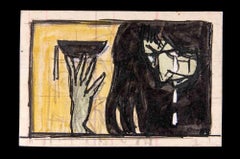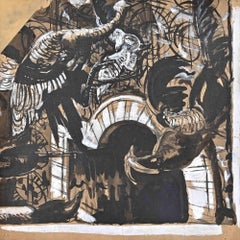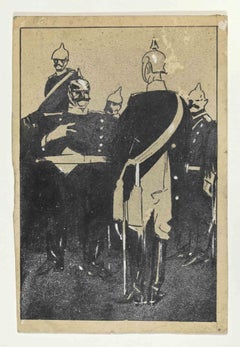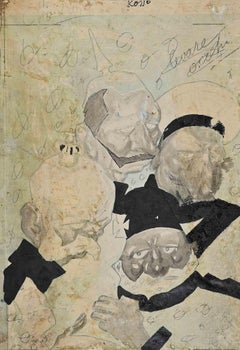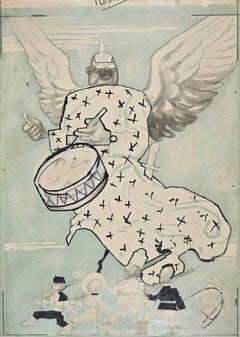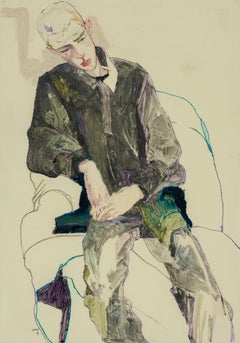Pen Figurative Drawings and Watercolors
to
15
9
5
1
15
Overall Height
to
Overall Width
to
15
14
9
8
5
3
3
2
2
1
1
1
1
1
1
1
15
2
6
170
15
10
7
7
63
38
32
20
15
Style: Modern
Artist: Gabriele Galantara
Medium: Pen
Magic Tears - Drawing by Gabriele Galantara - The Early 20th Century
Located in Roma, IT
Magic Tears is a modern artwork by Gabriele Galantara (1865-1937) in the early 20th century.
The artwork has been realized in China ink, tempera and watercolor on cardboard.
Good ...
Category
1910s Modern Pen Figurative Drawings and Watercolors
Materials
Pen, Tempera, Watercolor
Gigantic Birds - Drawing by Gabriele Galantara - 1920s
Located in Roma, IT
Gigantic Birds is a modern artwork by Gabriele Galantara (1865-1937) in the early 20th century.
The artwork has been realized in Ink, Tempera, Watercolor, and White Lead on paper.
...
Category
1910s Modern Pen Figurative Drawings and Watercolors
Materials
Watercolor, Ink, Pen
Austrian Soldiers - Drawing by Gabriele Galantara - 1916
Located in Roma, IT
Austrian Soldiers is a modern artwork by Gabriele Galantara (1865-1937) in 1916.
The artwork was realized in China ink and watercolor on cardboard.
...
Category
1910s Modern Pen Figurative Drawings and Watercolors
Materials
Ink, Pen, Watercolor
The Woman - Drawing by Gabriele Galantara - 1905
Located in Roma, IT
The Woman is an artwork realized by Gabriele Galantara in 1905 Century.
Drawing in tempera, ink, and watercolor.
Monogrammed RL.
The status of preservation is good, aged.
Gabriel...
Category
Early 1900s Modern Pen Figurative Drawings and Watercolors
Materials
Ink, Tempera, Pen
The Terror Of Big Heads - Drawing by Gabriele Galantara - Early 20th Century
Located in Roma, IT
The Terror Of Big Heads is an original artwork realized by Gabriele Galantara in the Early 20th Century.
Drawing in ink, tempera and pen.
For the Cover of magazin "Asino" publishe...
Category
Early 20th Century Modern Pen Figurative Drawings and Watercolors
Materials
Ink, Tempera, Pen
The Call of War - Drawing by Gabriele Galantara - Early 20th Century
Located in Roma, IT
The Call of War is an original artwork realized by Gabriele Galantara in the Early 20th Century.
Drawing in ink, watercolour and pen.
For the Cover of magazin "L'Asino" published ...
Category
Early 20th Century Modern Pen Figurative Drawings and Watercolors
Materials
Ink, Watercolor, Pen
Architecture - Original Pen Drawing by Gabriele Galantara - 1910s
Located in Roma, IT
Architecture is an original drawing in pen on creamy squared paper realized by Gabriele Galantara (1865-1937) in 1910s.
In good conditions.
This is an original drawing representin...
Category
1910s Modern Pen Figurative Drawings and Watercolors
Materials
Pen
Austro-Hungarian Soldiers- Original Mixed Media by G. Galantara - Early 1900
Located in Roma, IT
Austro-Hungarian Soldiers is an original mixed media drawing in pencil and pen realized by Gabriele Galantara, the state of preservation of the artwork is good.
The artworks represe...
Category
Early 20th Century Modern Pen Figurative Drawings and Watercolors
Materials
Pen, Pencil
Satiric Scene For l’Asino - Pen and Pencil Drawing by G. Galantara - 1910s
Located in Roma, IT
Satiric Scene For l’asino is an original drawing in pencil and pen realized in 1910 ca. by Gabriele Galantara.
The state of preservation of the artwork is good.
The artwork with a ...
Category
1910s Modern Pen Figurative Drawings and Watercolors
Materials
Pen, Pencil
Maquette for L'Asino - Original Pencil and Pen Drawing by G. Galantara - 1900 ca
Located in Roma, IT
Maquette for L'Asino is an original mixed media drawing in pencil and pen realized by Gabriele Galantara, the state of preservation of the artwork is good.
The artworks represent a ...
Category
Early 20th Century Modern Pen Figurative Drawings and Watercolors
Materials
Pen, Pencil
Satiric Scene for L'Asino - Original Drawing by G. Galantara -Early 20th Century
Located in Roma, IT
Satiric Scene For l’Asino is an original drawing in pencil and pen on the wooden panel realized by Gabriele Galantara.
The state of preservation of the artwork is good.
The artwork...
Category
Early 20th Century Modern Pen Figurative Drawings and Watercolors
Materials
Pen, Pencil
Toward Rest - Original Pen Drawing by Gabriele Galantara - Early 20th Century
Located in Roma, IT
Toward Rest is an original drawing in pen realized by Gabriele Galantara, Titled in Italian on the lower right" Verso il Riposo"
The state of preservation of the artwork is good, ex...
Category
Early 20th Century Modern Pen Figurative Drawings and Watercolors
Materials
Pen
Pic Nic on mountains Top - Pen and Pencil Drawing by G. Galantara - 1908
Located in Roma, IT
Pic nic on mountains top is an original drawing in pen and pencil on paper realized in 1908 ca. by Gabriele Galantara (1865-1937).
In good conditions.
The artwork is depicted skil...
Category
Early 1900s Modern Pen Figurative Drawings and Watercolors
Materials
Pen, Pencil
Study for l’Asino - Pencil and Pen Drawing by G. Galantara - Early 20th Century
Located in Roma, IT
Study for L’Asino is an original drawing in pencil and pen realized by Gabriele Galantara.
The state of preservation of the artwork is good, except for some missing piece of paper ...
Category
Early 20th Century Modern Pen Figurative Drawings and Watercolors
Materials
Pencil, Pen
Satirical Scene - Original Pen and Pencil by Gabriele Galantara - 1910s
Located in Roma, IT
Satiric Scene For l’Asino is an original drawing in pencil and pen on cardboard realized in 1910 ca. by Gabriele Galantara.
The state of preservation of the artwork is good.
The a...
Category
1910s Modern Pen Figurative Drawings and Watercolors
Materials
Pen, Pencil
Related Items
The Abduction of the Sabine Women , a Renaissance drawing by Biagio Pupini
Located in PARIS, FR
This vigorous drawing has long been attributed to Polidoro da Caravaggio: The Abduction of the Sabine Women is one of the scenes that Polidoro depicted between 1525 and 1527 on the façade of the Milesi Palazzo in Rome. However, the proximity to another drawing inspired by this same façade, kept at the Ecole des Beaux-Arts, and to other drawings inspired by Polidoro kept at the Musée du Louvre, leads us to propose an attribution to Biagio Pupini, a Bolognese artist whose life remains barely known, despite the abundant number of drawings attributed to him.
1. Biagio Pupini, a Bolognese artist in the light of the Roman Renaissance
The early life of Biagio Pupini, an important figure of the first half of the Cinquecento in Bologna - Vasari mentions him several times - is still poorly known. Neither his date of birth (probably around 1490-1495) nor his training are known. He is said to have been a pupil of Francesco Francia (1450 - 1517) and his name appears for the first time in 1511 in a contract with the painter Bagnacavallo (c. 1484 - 1542) for the frescoes of a church in Faenza. He then collaborated with Girolamo da Carpi, at San Michele in Bosco and at the villa of Belriguardo.
He must have gone to Rome for the first time with Bagnacavallo between 1511 and 1519. There he discovered the art of Raphael, with whom he might have worked, and that of Polidoro da Caravaggio. This first visit, and those that followed, were the occasion for an intense study of ancient and modern art, as illustrated by his abundant graphic production.
Polidoro da Caravaggio had a particular influence on the technique adopted by Pupini. Executed on coloured paper, his drawings generally combine pen, brown ink and wash with abundant highlights of white gouache, as in the drawing presented here.
2. The Abduction of the Sabine Women
Our drawing is an adaptation of a fresco painted between 1525 and 1527 by Polidoro da Caravaggio on the façade of the Milesi Palace in Rome. These painted façades were very famous from the moment they were painted and inspired many artists during their stay in Rome. These frescoes are now very deteriorated and difficult to see, as the palace is in a rather narrow street.
The episode of the abduction of the Sabine women (which appears in the centre of the photo above) is a historical theme that goes back to the origins of Rome and is recounted both by Titus Livius (Ab Urbe condita I,13), by Ovid (Fasti III, 199-228) and by Plutarch (II, Romulus 14-19). After killing his twin brother Romus, Romulus populates the city of Rome by opening it up to refugees and brigands and finds himself with an excess of men. Because of their reputation, none of the inhabitants of the neighbouring cities want to give them their daughters in marriage. The Romans then decide to invite their Sabine neighbours to a great feast during which they slaughter the Sabines and kidnap their daughters.
The engraving made by Giovanni Battista Gallestruzzi (1618 - 1677) around 1656-1658 gives us a good understanding of the Polidoro fresco, allowing us to see how Biagio Pupini reworked the scene to extract this dynamic group.
With a remarkable economy of means, Biagio Pupini takes over the left-hand side of the fresco and depicts in a very dense space two main groups, each consisting of a Roman and a Sabine, completed by a group of three soldiers in the background (which seems to differ quite significantly from Polidoro's composition).
The balance of the drawing is based on a very strongly structured composition. The drawing is organised around a median vertical axis, which runs along both the elbow of the kidnapped Sabine on the left and the foot of her captor, and the two main diagonals, reinforced by four secondary diagonals. This diamond-shaped structure creates an extremely dynamic space, in which centripetal movements (the legs of the Sabine on the right, the arm of the soldier on the back at the top right) and centrifugal movements (the arm of the kidnapper on the left and the legs of the Sabine he is carrying away, the arm of the Sabine on the right) oppose each other, giving the drawing the appearance of a whirlpool around a central point of support situated slightly to the left of the navel of the kidnapper on the right.
3. Polidoro da Caravaggio, and the decorations of Roman palaces
Polidoro da Caravaggio was a paradoxical artist who entered Raphael's (1483 - 1520) workshop at a very young age, when he oversaw the Lodges in the Vatican. Most of his Roman work, which was the peak of his career, has disappeared, as he specialised in facade painting, and yet these paintings, which are eminently visible in urban spaces, have influenced generations of artists who copied them abundantly during their visits to Rome.
Polidoro Caldara was born in Caravaggio around 1495-1500 (the birthplace of Michelangelo Merisi, known as Caravaggio, who was born there in 1571), some forty kilometres east of Milan. According to Vasari, he arrived as a mason on the Vatican's construction site and joined Raphael's workshop around 1517 (at the age of eighteen according to Vasari). This integration would have allowed Polidoro to work not only on the frescoes of the Lodges, but also on some of the frescoes of the Chambers, as well as on the flat of Cardinal Bibiena in the Vatican.
After Raphael's death in 1520, Polidoro worked first with Perin del Vaga before joining forces with Maturino of Florence (1490 - 1528), whom he had also known in Raphael's workshop. Together they specialised in the painting of palace façades. They were to produce some forty façades decorated with grisaille paintings imitating antique bas-reliefs.
The Sack of Rome in 1527, during which his friend Maturino was killed, led Polidoro to flee first to Naples (where he had already stayed in 1523), then to Messina. It was while he was preparing his return to the peninsula that he was murdered by one of his assistants, Tonno Calabrese, in 1543.
In his Vite, Vasari celebrated Polidoro as the greatest façade decorator of his time, noting that "there is no flat, palace, garden or villa in Rome that does not contain a work by Polidoro". Polidoro's facade decorations, most of which have disappeared as they were displayed in the open air, constitute the most important lost chapter of Roman art of the Cinquecento. The few surviving drawings of the painter can, however, give an idea of the original appearance of his murals and show that he was an artist of remarkable and highly original genius.
4. The façade of the Milesi Palace
Giovanni Antonio Milesi, who commissioned this palace, located not far from the Tiber, north of Piazza Navona, was a native of the Bergamo area, like Polidoro, with whom he maintained close friendly ties. Executed in the last years before the Sack of Rome, around 1526-1527, the decoration of Palazzo Milesi is considered Polidoro's greatest decorative success.
An engraving by Ernesto Maccari made at the end of the nineteenth century allows us to understand the general balance of this façade, which was still well preserved at the time. The frescoes were not entirely monochrome, but alternated elements in chiaroscuro simulating marble bas-reliefs and those in ochre simulating bronze and gold vases...
Category
16th Century Old Masters Pen Figurative Drawings and Watercolors
Materials
Ink, Gouache, Pen
Lee Hurst (3/4 Figure, Hands Together), Mixed media on Pergamenata parchment
Located in London, GB
Howard Tangye (b.1948, Australia) has been an influential force in fashion for decades. Lecturing at London’s Central Saint Martins for 35 years, including 16 years as head of BA Wom...
Category
2010s Contemporary Pen Figurative Drawings and Watercolors
Materials
Paint, Paper, Parchment Paper, Charcoal, Crayon, Oil Crayon, Oil Pastel,...
Morning stretches
Located in Sempach, LU
A quick live sketch is always a little imperfect - too little time and too much adrenaline in the blood at this moment, but it perfectly conveys the delight of beauty and, as the Fre...
Category
2010s Realist Pen Figurative Drawings and Watercolors
Materials
Paper, Tempera, Permanent Marker
Katya
Located in Sempach, LU
This is one of those sketches where Evgeniy Monahov first used an industrial marker together with tempera - the thick velvety black of his lines expands the tonal range of the delica...
Category
2010s Realist Pen Figurative Drawings and Watercolors
Materials
Permanent Marker, Tempera, Paper
The Sketch Class, Figurative Study Line Drawing
Located in Soquel, CA
Expressive line drawing figure study featuring a group of figures in a classroom by David Rosen (Canadian, 1912-2004). Unsigned, but was acquire...
Category
Late 20th Century American Modern Pen Figurative Drawings and Watercolors
Materials
Paper, Pen, Watercolor
H 12 in W 8 in D 0.25 in
Cats Watching a Witch on a Broomstick - Vintage Halloween Illustration in Ink
Located in Soquel, CA
Cats Watching a Witch on a Broomstick - Vintage Halloween Illustration in Ink
Halloween scene with cats and a witch in India ink pen by Irene Pattinson (American, 1909-1999). A blac...
Category
1950s American Modern Pen Figurative Drawings and Watercolors
Materials
Paper, Watercolor, Pen, India Ink
H 18 in W 20 in D 0.25 in
Freya (Seated Backwards), Mixed media on grey board
Located in London, GB
Howard Tangye (b.1948, Australia) has been an influential force in fashion for decades. Lecturing at London’s Central Saint Martins for 35 years, including 16 years as head of BA Wom...
Category
2010s Contemporary Pen Figurative Drawings and Watercolors
Materials
Other Medium, Archival Paper, Handmade Paper, Pen, Felt Pen, Permanent M...
Nude Girl
Located in Santa Fe, NM
A rare Ink on Paper nude figure drawing by Milton Hebald, beautifully executed on a lovely blue Italian rag paper. Given the stylization, it is likely a study for one of his sculptures. Hebald is regarded as one of the most important American figurative sculptors...
Category
Late 20th Century American Modern Pen Figurative Drawings and Watercolors
Materials
Ink, Tempera, Paper
Untitled image of woman smoking by modernist painter Hugó Scheiber
Located in Hudson, NY
This artwork is framed with non-reflective, UV protection Museum glass. The frame size is 15.5" x 12.75"
About this artist: Hugó Scheiber was born in Budapest, Hungary in 1873. His ...
Category
Early 20th Century Modern Pen Figurative Drawings and Watercolors
Materials
Tempera, Gouache, Paper
Bull Ring Brass - Mexico City
Located in Fairlawn, OH
Bull Ring Brass - Mexico City
Watercolor, pen and ink on paper, 1955
Signed in ink, dated and titled in pencil (see photos)
Condition: 1'' repaired tear left edge, along with other ...
Category
1950s American Modern Pen Figurative Drawings and Watercolors
Materials
India Ink, Watercolor, Pen
Two girls reading a book
Located in Sempach, LU
Just another evening in the artist's studio, when the guests arrived and sat down to look at all kinds of art books. Two girls were so carried away by the book that they no longer no...
Category
2010s Realist Pen Figurative Drawings and Watercolors
Materials
Paper, Tempera, Permanent Marker
Pigs on a Trolley - Vintage Picture Book Two-Page Spread Illustration
Located in Soquel, CA
Pigs on a Trolley - Vintage Picture Book Two-Page Spread Illustration
A two-page spread in India ink pen and watercolor by Irene Pattinson (Ameri...
Category
1950s American Modern Pen Figurative Drawings and Watercolors
Materials
Paper, India Ink, Watercolor, Pen
H 17 in W 30 in D 0.25 in
Pen figurative drawings and watercolors for sale on 1stDibs.
Find a wide variety of authentic Pen figurative drawings and watercolors available on 1stDibs. While artists have worked in this medium across a range of time periods, art made with this material during the 21st Century is especially popular. If you’re looking to add figurative drawings and watercolors created with this material to introduce a provocative pop of color and texture to an otherwise neutral space in your home, the works available on 1stDibs include elements of orange, blue, yellow, purple and other colors. There are many well-known artists whose body of work includes ceramic sculptures. Popular artists on 1stDibs associated with pieces like this include Mino Maccari, Gabriele Galantara, Irene Pattinson, and Sunil Das. Frequently made by artists working in the Modern, Contemporary, all of these pieces for sale are unique and many will draw the attention of guests in your home. Not every interior allows for large Pen figurative drawings and watercolors, so small editions measuring 0.25 inches across are also available Prices for figurative drawings and watercolors made by famous or emerging artists can differ depending on medium, time period and other attributes. On 1stDibs, the price for these items starts at $11 and tops out at $648,500, while the average work can sell for $411.
